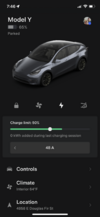We had a discussion recently about cell temperstures in the battery and after looking into this I’d say that the battery is averaging quite much above the ambient for a day with charging/ driving/ standing in the sun.
When cold the car use the heat to keep the driver happy, and this keeps the battery cold(heatingthe cabin cools the battery) but when not cold the battery temp goes up instrad of ”down”.
I have a average battery temp since september thats 12.25C. September tonow is the cold period with heating at my place.
Today I left the car in the sun at work (not that high elevation up here, and it was not a clear sky all day, but partly sun shine). The ambient was about 10C when driving to work and 15C leaving work. Average outside temp 14C. Highest temp was 17-18C,(19C is probably the sensor being heated from direct sun light.)
The average cell temp is 25.6C despite not many drives. 2 x 46 km to/from work and some short drive in the home town, to the supermarket etc.
This is > 10C above the average ambient temp. Not worried for my car but the statement from someone here about the cell temp being only a few or five degrees above ambient do not seem probable.
Living in a hot climate probably sky rocket the average cell temp, specially when the car stands inthe sun.
View attachment 803759
View attachment 803761



